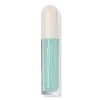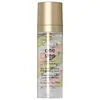What's inside
What's inside
 Key Ingredients
Key Ingredients

 Benefits
Benefits

 Concerns
Concerns

 Ingredients Side-by-side
Ingredients Side-by-side

Water
Skin ConditioningCyclopentasiloxane
EmollientGlycerin
HumectantPropylene Glycol
HumectantDimethicone
EmollientCetyl PEG/PPG-10/1 Dimethicone
EmulsifyingIsododecane
EmollientPEG/PPG-18/18 Dimethicone
EmulsifyingMica
Cosmetic ColorantDisteardimonium Hectorite
StabilisingSodium Chloride
MaskingPhenoxyethanol
PreservativeSorbitan Sesquioleate
EmulsifyingTribehenin
EmollientPolysilicone-11
Dimethicone/Vinyl Dimethicone Crosspolymer
Skin ConditioningHdi/Trimethylol Hexyllactone Crosspolymer
Silica
AbrasiveMethicone
EmollientCarthamus Tinctorius Seed Oil
MaskingPropylene Carbonate
SolventTocopheryl Acetate
AntioxidantBHT
AntioxidantDisodium EDTA
Paraffinum Liquidum
EmollientAloe Barbadensis Leaf Extract
EmollientCamellia Sinensis Leaf Extract
AntimicrobialChamomilla Recutita Flower Extract
MaskingMelaleuca Alternifolia Leaf Oil
AntioxidantCI 77891
Cosmetic ColorantIron Oxides
CI 77007
Cosmetic ColorantCI 77289
Cosmetic ColorantCI 77288
Cosmetic ColorantWater, Cyclopentasiloxane, Glycerin, Propylene Glycol, Dimethicone, Cetyl PEG/PPG-10/1 Dimethicone, Isododecane, PEG/PPG-18/18 Dimethicone, Mica, Disteardimonium Hectorite, Sodium Chloride, Phenoxyethanol, Sorbitan Sesquioleate, Tribehenin, Polysilicone-11, Dimethicone/Vinyl Dimethicone Crosspolymer, Hdi/Trimethylol Hexyllactone Crosspolymer, Silica, Methicone, Carthamus Tinctorius Seed Oil, Propylene Carbonate, Tocopheryl Acetate, BHT, Disodium EDTA, Paraffinum Liquidum, Aloe Barbadensis Leaf Extract, Camellia Sinensis Leaf Extract, Chamomilla Recutita Flower Extract, Melaleuca Alternifolia Leaf Oil, CI 77891, Iron Oxides, CI 77007, CI 77289, CI 77288
Water
Skin ConditioningCyclopentasiloxane
EmollientPropylene Glycol
HumectantZinc Oxide
Cosmetic ColorantOctyldodecyl Neopentanoate
EmollientGlycerin
HumectantTitanium Dioxide
Cosmetic ColorantButylene Glycol
HumectantPhenoxyethanol
PreservativeCarbomer
Emulsion StabilisingMica
Cosmetic ColorantPEG/PPG-18/18 Dimethicone
EmulsifyingDimethicone
EmollientSodium Hydroxide
BufferingCI 77891
Cosmetic ColorantAluminum Hydroxide
EmollientStearic Acid
CleansingCI 77491
Cosmetic ColorantCI 77288
Cosmetic ColorantBoron Nitride
AbsorbentCaprylyl Glycol
EmollientCI 77492
Cosmetic ColorantCI 77007
Cosmetic ColorantSodium Dehydroacetate
PreservativeMethylparaben
PreservativePhytantriol
HumectantGlyceryl Acrylate/Acrylic Acid Copolymer
HumectantDisodium EDTA
Triethoxycaprylylsilane
Hexylene Glycol
EmulsifyingPalmitic Acid
EmollientPropylparaben
PreservativeDextrin Palmitate
EmulsifyingTetrahexyldecyl Ascorbate
AntioxidantTocopherol
AntioxidantTocopheryl Acetate
AntioxidantCI 77499
Cosmetic ColorantRetinyl Palmitate
Skin ConditioningMagnesium Ascorbyl Phosphate
AntioxidantLysine
Skin ConditioningAnthemis Nobilis Flower Extract
MaskingCamellia Sinensis Leaf Extract
AntimicrobialGinkgo Biloba Leaf Extract
Skin ConditioningPanax Ginseng Root Extract
EmollientSodium Hyaluronate
HumectantPotassium Chloride
Magnesium Chloride
Sodium Chloride
MaskingZinc Chloride
AntimicrobialPotassium Sorbate
PreservativeMontmorillonite
AbsorbentIllite
AbrasiveKaolin
AbrasiveWater, Cyclopentasiloxane, Propylene Glycol, Zinc Oxide, Octyldodecyl Neopentanoate, Glycerin, Titanium Dioxide, Butylene Glycol, Phenoxyethanol, Carbomer, Mica, PEG/PPG-18/18 Dimethicone, Dimethicone, Sodium Hydroxide, CI 77891, Aluminum Hydroxide, Stearic Acid, CI 77491, CI 77288, Boron Nitride, Caprylyl Glycol, CI 77492, CI 77007, Sodium Dehydroacetate, Methylparaben, Phytantriol, Glyceryl Acrylate/Acrylic Acid Copolymer, Disodium EDTA, Triethoxycaprylylsilane, Hexylene Glycol, Palmitic Acid, Propylparaben, Dextrin Palmitate, Tetrahexyldecyl Ascorbate, Tocopherol, Tocopheryl Acetate, CI 77499, Retinyl Palmitate, Magnesium Ascorbyl Phosphate, Lysine, Anthemis Nobilis Flower Extract, Camellia Sinensis Leaf Extract, Ginkgo Biloba Leaf Extract, Panax Ginseng Root Extract, Sodium Hyaluronate, Potassium Chloride, Magnesium Chloride, Sodium Chloride, Zinc Chloride, Potassium Sorbate, Montmorillonite, Illite, Kaolin
Ingredients Explained
These ingredients are found in both products.
Ingredients higher up in an ingredient list are typically present in a larger amount.
Camellia Sinensis Leaf Extract is derived from the leaves of the tea plant. Black tea, green tea, and oolong tea are all harvested from this plant.
This ingredient has many skin benefits:
This ingredient contains polyphenols, a strong antioxidant. Antioxidants help fight off molecules that damage skin cells.
On top of that, the antioxidants in green tea neutralize free-radicals from the sun. This gives the skin some extra UV protection, but should not replace sunscreen.
Many components of tea have anti-inflammatory properties.
Polyphenols and L-theanine help soothe the skin and reduce irritation. The caffeine in Camellia Sinensis Leaf Extract helps calm inflamed blood vessels.
Other compounds found in tea include: Vitamin Bs, linoleic acid, magnesium, calcium, iron, and zinc.
Research has shown both drinking Camellia Sinensis Leaf Tea and applying it to the skin can help boost skin elasticity and hydration. Studies also show using tea extract may reduce sebum, or oil, production.
Learn more about Camellia Sinensis Leaf ExtractThis pigment is called Ultramarine blue lazurite. It gives a saturated blue color, but can be used to create other colors as well.
According to the manufacturer, it is usually made from kaolin, sodium sulfate, sodium carbonate, sulfur, and charcoal.
Ci 77288 is used to add green pigment to products.
Ci 77891 is a white pigment from Titanium dioxide. It is naturally found in minerals such as rutile and ilmenite.
It's main function is to add a white color to cosmetics. It can also be mixed with other colors to create different shades.
Ci 77891 is commonly found in sunscreens due to its ability to block UV rays.
Learn more about CI 77891Cyclopentasiloxane, or D5, is a silicone used to improve texture of products and trap moisture.
D5 is considered lightweight and volatile. Volatile means it evaporates quickly after application. Once evaporated, D5 leaves a thin barrier that helps keep skin hydrated.
It is also an emollient. Emollients help soften the skin and prevent water loss. Silicones create a silky texture in products. D5 helps other ingredients become more spreadable.
Studies show D5 is safe to use in skincare products. We recommend speaking with a skincare professional if you have concerns.
Learn more about CyclopentasiloxaneDimethicone is a type of synthetic silicone created from natural materials such as quartz.
What it does:
Dimethicone comes in different viscosities:
Depending on the viscosity, dimethicone has different properties.
Ingredients lists don't always show which type is used, so we recommend reaching out to the brand if you have questions about the viscosity.
This ingredient is unlikely to cause irritation because it does not get absorbed into skin. However, people with silicone allergies should be careful about using this ingredient.
Note: Dimethicone may contribute to pilling. This is because it is not oil or water soluble, so pilling may occur when layered with products. When mixed with heavy oils in a formula, the outcome is also quite greasy.
Learn more about DimethiconeDisodium EDTA plays a role in making products more stable by aiding other preservatives.
It is a chelating agent, meaning it neutralizes metal ions that may be found in a product.
Disodium EDTA is a salt of edetic acid and is found to be safe in cosmetic ingredients.
Learn more about Disodium EDTAGlycerin is already naturally found in your skin. It helps moisturize and protect your skin.
A study from 2016 found glycerin to be more effective as a humectant than AHAs and hyaluronic acid.
As a humectant, it helps the skin stay hydrated by pulling moisture to your skin. The low molecular weight of glycerin allows it to pull moisture into the deeper layers of your skin.
Hydrated skin improves your skin barrier; Your skin barrier helps protect against irritants and bacteria.
Glycerin has also been found to have antimicrobial and antiviral properties. Due to these properties, glycerin is often used in wound and burn treatments.
In cosmetics, glycerin is usually derived from plants such as soybean or palm. However, it can also be sourced from animals, such as tallow or animal fat.
This ingredient is organic, colorless, odorless, and non-toxic.
Glycerin is the name for this ingredient in American English. British English uses Glycerol/Glycerine.
Learn more about GlycerinMica is a naturally occurring mineral used to add shimmer and color in cosmetics. It can also help improve the texture of a product or give it an opaque, white/silver color.
Serecite is the name for very fine but ragged grains of mica.
This ingredient is often coated with metal oxides like titanium dioxide. Trace amounts of heavy metals may be found in mica, but these metals are not harmful in our personal products.
Mica has been used since prehistoric times throughout the world. Ancient Egyptian, Indian, Greek, Roman, Aztec, and Chinese civilizations have used mica.
Learn more about MicaPEG/PPG-18/18 Dimethicone is a type of silicone.
Phenoxyethanol is a preservative that has germicide, antimicrobial, and aromatic properties. Studies show that phenoxyethanol can prevent microbial growth. By itself, it has a scent that is similar to that of a rose.
It's often used in formulations along with Caprylyl Glycol to preserve the shelf life of products.
Propylene Glycol is an odorless, colorless liquid. As a humectant, it helps skin retain moisture. It also aids in delivering active ingredients.
Another role of this ingredient is preventing a product from melting or freezing. Propylene glycol also adds antimicrobrial properties to a product, elongating product lifespan.
This ingredient is considered an organic alcohol and commonly added into both cosmetics and foods.
Those with sensitive skin or conditions may develop a rash when using this ingredient.
Learn more about Propylene GlycolChances are, you eat sodium chloride every day. Sodium Chloride is also known as table salt.
This ingredient has many purposes in skincare: thickener, emulsifier, and exfoliator.
You'll most likely find this ingredient in cleansers where it is used to create a gel-like texture. As an emulsifier, it also prevents ingredients from separating.
There is much debate on whether this ingredient is comedogenic. The short answer - comedogenic ratings don't tell the whole story. Learn more about comegodenic ratings here.
The concensus about this ingredient causing acne seems to be divided. Research is needed to understand if this ingredient does cause acne.
Scrubs may use salt as the primary exfoliating ingredient.
Learn more about Sodium ChlorideTocopheryl Acetate is AKA Vitamin E. It is an antioxidant and protects your skin from free radicals. Free radicals damage the skin by breaking down collagen.
One study found using Tocopheryl Acetate with Vitamin C decreased the number of sunburned cells.
Tocopheryl Acetate is commonly found in both skincare and dietary supplements.
Learn more about Tocopheryl AcetateWater. It's the most common cosmetic ingredient of all. You'll usually see it at the top of ingredient lists, meaning that it makes up the largest part of the product.
So why is it so popular? Water most often acts as a solvent - this means that it helps dissolve other ingredients into the formulation.
You'll also recognize water as that liquid we all need to stay alive. If you see this, drink a glass of water. Stay hydrated!
Learn more about Water